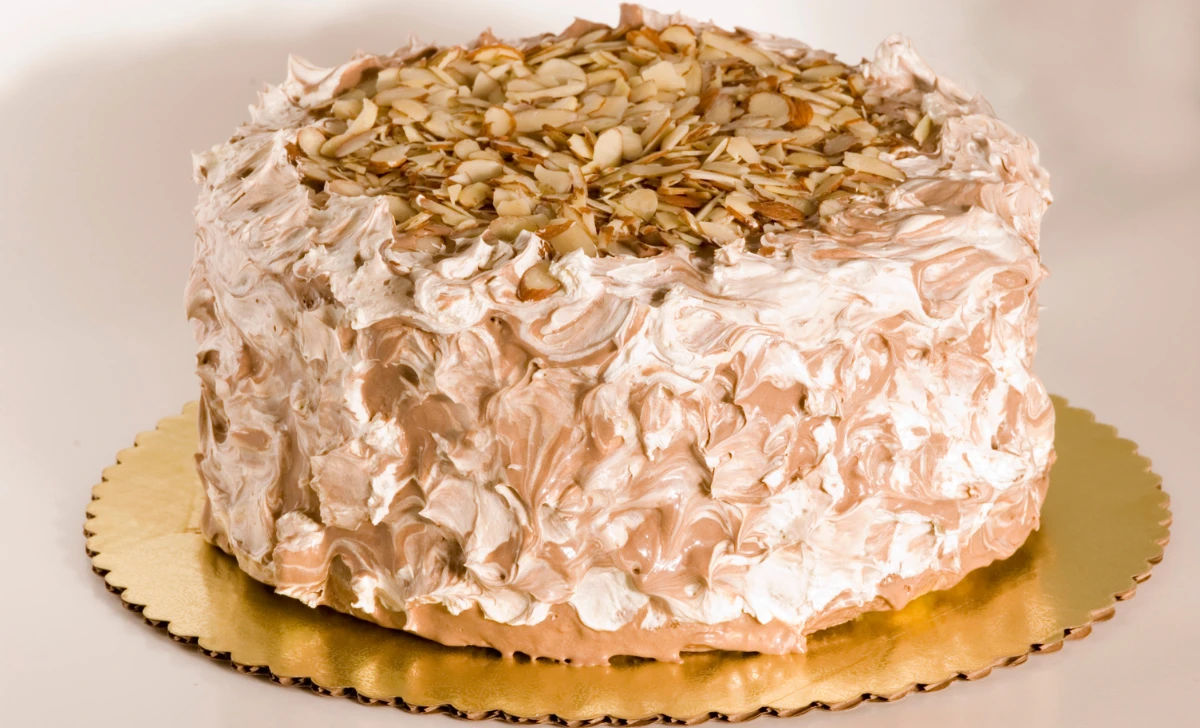Are you a fan of delectable desserts? Do you enjoy the delightful taste of almonds? If so, you’re in for a treat! In this article, I’m going to share with you an irresistible Almond Cake recipe that will tantalize your taste buds and leave you craving for more. Baking a perfect almond cake may seem like a daunting task, but fear not! I’ll guide you through every step, making it a breeze even for beginners. So let’s roll up our sleeves and get ready to create a mouthwatering masterpiece!
[ez-toc]
History
The history of Almond Cake traces back centuries, taking us on a delightful journey through various cultures and civilizations that have cherished this nutty dessert. Let’s dive into the past and explore how this delectable treat evolved into the beloved culinary masterpiece we know today.
Ancient Beginnings
The roots of Almond Cakes can be traced back to ancient civilizations, where almonds were cherished for their taste and nutritional value. The Romans were among the first to incorporate almonds into their desserts, using them in various sweet dishes and cakes. Almonds were considered a luxurious ingredient, often reserved for special occasions and royalty.
Medieval Europe and the Middle East
During the Middle Ages, Almond Cakes gained popularity across Europe, particularly in countries like Spain and Italy. These regions embraced almonds as a staple in their cuisine, leading to the development of various almond-based desserts, including the early versions of Almond Cakes.
Almonds also played a significant role in Middle Eastern desserts, where they were used in pastries and confections like baklava. It was through trade and cultural exchange that the knowledge of almond-based desserts spread across continents, enriching culinary traditions worldwide.
Renaissance and Beyond
As Europe entered the Renaissance period, the popularity of Almond Cakes continued to soar. The recipe for these cakes evolved, and more ingredients like sugar, eggs, and butter were added to enhance their flavor and texture. Almond Cakes became synonymous with celebrations, feasts, and joyous gatherings.
Colonial Influence and Global Spread
The colonial era played a crucial role in introducing Almond Cakes to new corners of the world. European colonizers brought their culinary traditions, including the love for Almond Cakes, to far-off lands. As a result, the delightful dessert reached places like the Americas, Asia, and Africa, where it merged with local flavors and culinary practices.
Industrial Revolution and Modern Adaptations
With the advent of the Industrial Revolution, baking techniques and tools improved, making it easier for people to enjoy Almond Cakes at home. The availability of mass-produced ingredients further popularized the dessert. Cookbooks from the 19th and 20th centuries featured numerous Almond Cake recipes, solidifying its place in the hearts of home bakers.
Cultural Significance and Symbolism
Throughout history, Almond Cakes have held cultural significance in various regions. In some cultures, almonds symbolize good luck, prosperity, and fertility, making Almond Cakes a popular choice for weddings and festive occasions. Additionally, the cake’s nutty flavor and soft texture have been associated with comfort and indulgence, making it a go-to dessert for moments of joy and relaxation.
Modern-Day Almond Cakes
In today’s culinary landscape, Almond Cakes continue to be cherished and enjoyed by people of all ages. From classic recipes passed down through generations to innovative variations with unique twists, the love for Almond Cakes remains unwavering.
Time
| Step | Time |
|---|---|
| Preparing the Almond Cake Batter | 15 minutes |
| Baking the Cake | 35-40 minutes |
| Making Buttercream Frosting | 10 minutes |
| Making Cream Cheese Frosting | 15 minutes |
| Decorating Your Almond Cake | 20 minutes |
| Cooling and Frosting the Cake | 15 minutes |
| Optional: Chocolate Infusion Experiment | 20 minutes |
| Optional: Fruity Twists Experiment | 15 minutes |
| Cleanup and Kitchen Tidy-Up | 10 minutes |
| Total Time | 2 hours |
Please note that the total time is an approximation and may vary based on individual baking and decorating skills. Additionally, some steps like baking time may be affected by the type of oven used. Always check for doneness using a toothpick or cake tester to ensure the cake is fully baked. Happy baking!
Ingredients
| Ingredients | Quantity for 2 Servings |
|---|---|
| Almonds (Ground) | 1 cup |
| All-Purpose Flour | 1/2 cup |
| Baking Powder | 1 teaspoon |
| Salt | 1/4 teaspoon |
| Unsalted Butter (Softened) | 1/2 cup |
| Granulated Sugar | 1/2 cup |
| Eggs (Large) | 2 |
| Pure Vanilla Extract | 1 teaspoon |
| Milk | 1/2 cup |
| Almond Extract | 1/2 teaspoon |
Please note that this ingredient list is specifically tailored for making an Almond Cake that serves two people. If you plan to serve more individuals, you can adjust the quantities accordingly. Happy baking and enjoy your scrumptious Almond Cake!
Directions
Step 1 – Preparing the Almond Cake Batter
- Preparation: Preheat your oven to 350°F (175°C) and grease a 9-inch round cake pan with butter or cooking spray.
- Combine Dry Ingredients: In a mixing bowl, whisk together 1 cup of ground almonds, 1/2 cup of all-purpose flour, 1 teaspoon of baking powder, and 1/4 teaspoon of salt until well combined.
- Creaming Butter and Sugar: In a separate bowl, cream 1/2 cup of softened unsalted butter with 1/2 cup of granulated sugar until light and fluffy using an electric mixer or a whisk.
- Adding Eggs and Extracts: Beat in 2 large eggs, one at a time, until fully incorporated. Then, mix in 1 teaspoon of pure vanilla extract and 1/2 teaspoon of almond extract for that nutty goodness.
- Incorporating Dry Ingredients: Gradually add the dry ingredient mixture to the wet ingredients, alternating with 1/2 cup of milk. Mix on low speed until just combined, avoiding overmixing.
Step 2 – Baking the Cake
- Filling the Pan: Pour the prepared Almond Cake batter into the greased cake pan, spreading it evenly with a spatula.
- Baking Time: Place the pan in the preheated oven and bake for 35 to 40 minutes or until a toothpick inserted into the center comes out clean.
- Cooling: Once the cake is baked to perfection, remove it from the oven and let it cool in the pan for 10 minutes. Then, transfer the cake to a wire rack to cool completely.
Step 3 – Making Buttercream Frosting
- Ingredients: For buttercream frosting, you’ll need 1/2 cup of softened unsalted butter, 1 1/2 cups of powdered sugar, and 1 teaspoon of pure vanilla extract.
- Whipping the Frosting: In a mixing bowl, beat the softened butter on medium speed until smooth and creamy. Gradually add the powdered sugar, mixing until the frosting becomes fluffy and light. Stir in the vanilla extract for a delightful flavor.
Step 4 – Making Cream Cheese Frosting
- Ingredients: For cream cheese frosting, prepare 4 ounces of softened cream cheese, 1/4 cup of softened unsalted butter, 1 cup of powdered sugar, and 1 teaspoon of pure vanilla extract.
- Blending the Frosting: In a bowl, combine the softened cream cheese and butter, beating until well blended and smooth. Gradually add the powdered sugar and mix until the frosting reaches a creamy consistency. Add the vanilla extract for a delightful touch of flavor.
Step 5 – Decorating Your Almond Cake
- Leveling the Cake: If the top of your cake has a domed shape, you can level it using a serrated knife to create a flat surface.
- Applying Frosting: Choose either the buttercream or cream cheese frosting to spread evenly over the cooled Almond Cake using a spatula or a piping bag for a decorative touch.
- Get Creative: Feel free to get creative with your cake’s decoration. You can sprinkle toasted almond slivers, edible flowers, or even chocolate shavings on top.
Step 6 – Cleanup and Kitchen Tidy-Up
- Enjoying Your Creation: Now that your Almond Cake is baked, frosted, and beautifully decorated, it’s time to indulge in this delightful treat!
- Cleanup Time: After savoring the cake, it’s time to clean up your workspace. Wash the utensils, mixing bowls, and cake pan with warm soapy water.
- Storing Leftovers: If there are any leftovers, store the cake in an airtight container at room temperature for up to 2 days or in the refrigerator for longer freshness.
Now that you’ve successfully baked and decorated your Almond Cake, it’s time to relish its delightful flavor. Share this delectable treat with your loved ones and enjoy the sweetness it brings to your moments of joy! Happy baking!
Equipment Required
Nutrition Information
| Nutrition Information (Per Serving) | Amount |
|---|---|
| Serving Size | 1 slice |
| Calories | 350 kcal |
| Total Fat | 20g |
| – Saturated Fat | 10g |
| Cholesterol | 90mg |
| Sodium | 180mg |
| Total Carbohydrates | 40g |
| – Dietary Fiber | 2g |
| – Sugars | 28g |
| Protein | 4g |
| Vitamin D | 1.5mcg |
| Calcium | 50mg |
| Iron | 1.5mg |
| Potassium | 120mg |
Please note that the nutrition information provided is approximate and may vary based on specific ingredients used and portion sizes. It’s always a good idea to refer to the product labels or use a nutrition calculator to get the most accurate data for your specific Almond Cake recipe. Enjoy your delicious and nutritious treat!
Tips
- Room Temperature Ingredients: Allow all refrigerated ingredients, such as butter, eggs, and milk, to come to room temperature before starting. Room temperature ingredients blend better and create a smoother batter.
- Measuring Flour Correctly: For accurate measurements, spoon the flour into the measuring cup and level it off with a knife. Avoid packing the flour into the cup, as it can lead to a denser cake.
- Don’t Overmix: When combining the wet and dry ingredients, mix just until everything is incorporated. Overmixing can result in a tough cake.
- Test for Doneness: To check if the cake is fully baked, insert a toothpick or cake tester into the center. If it comes out clean or with a few moist crumbs, the cake is ready.
- Cooling the Cake: Allow the cake to cool in the pan for 10 minutes before removing it to prevent it from sticking. Once on a wire rack, let it cool completely before frosting.
- Frosting Consistency: Adjust the frosting consistency to your liking by adding more powdered sugar for a thicker frosting or a little milk for a smoother texture.
- Almond Flour Substitution: If you don’t have ground almonds, you can use almond flour as a substitute. The texture will be slightly different, but the flavor will remain delightful.
- Experiment with Flavors: Don’t be afraid to experiment with different extracts or add a pinch of cinnamon or nutmeg to the batter for a unique twist.
- Adding Fruit: Enhance the cake’s taste by adding sliced or diced fruits like strawberries, peaches, or raspberries between the layers or as a topping.
- Nut Topping: Sprinkle some toasted almond slivers on top of the frosting for added crunch and a visually appealing finish.
Pros & Cons
| Pros | Cons |
|---|---|
| ✔️ Delightful and Nutty Flavor | ❌ High Calorie Content |
| ✔️ Moist and Tender Texture | ❌ Contains Saturated Fat |
| ✔️ Versatile for Various Occasions | ❌ Not Suitable for Nut Allergies |
| ✔️ Incorporates Nutrient-Rich Almonds | ❌ May Require Special Ingredients |
| ✔️ Easy to Customize and Decorate | ❌ Longer Preparation Time |
Conclusion
Congratulations, dear readers! You’ve embarked on a delectable journey through the enticing world of Almond Cakes, and the delightful aroma of this nutty dessert has surely captured your senses. From ancient civilizations to modern-day bakeries, Almond Cakes have stood the test of time, spreading joy and sweetness to countless hearts.
This Almond Cake recipe presents a delightful treat that is as easy to make as it is to savor. Its moist and tender texture, infused with the sweet allure of almonds, is a testament to the magic that unfolds in every bite. Whether you’re a seasoned baker looking for a new adventure or a beginner eager to impress, this recipe is the perfect fit for your culinary escapades.
With its versatility, you can customize this cake to suit any occasion. Whether it’s a special celebration, a cozy gathering, or simply a treat-yourself moment, the Almond Cake is the star that shines brightest on your dessert table. Topped with creamy frosting, adorned with toasted almond slivers, or enhanced with your favorite fruits, each creation becomes a masterpiece to delight and indulge.
As you bake this delightful Almond Cake, you’ll witness how the power of almonds brings joy to your taste buds and leaves you with memories to cherish. So why wait? Gather your ingredients, preheat the oven, and let the kitchen become your sanctuary of creativity and sweetness.
Let the aroma fill your home, and with each slice savored, share the joy with your loved ones, knowing that you’ve mastered a dessert that spans the ages and transcends cultural boundaries. Embrace the magic of almonds and create your own story with this timeless Almond Cake recipe.
So, don your apron, preheat your oven, and let the Almond Cake magic unfold. The journey awaits, and with each step, you’ll discover the joy of creating something delightful from the heart. And who knows, perhaps this humble cake will become a legacy in your family’s cookbook, passed down from generation to generation.
Indulge in the delightful taste, embrace the tender texture, and share the love with everyone around you. The Almond Cake awaits, and the magic is yours to create. Happy baking and savor every moment of this scrumptious adventure!
Facts
- 1. Almond Cakes: A Royal Favorite! 👑
- Did you know that Almond Cakes were a favorite among royalty and nobility in medieval Europe? Almonds were considered a luxury ingredient, and these delectable cakes graced the tables of kings and queens, making them a dessert fit for royalty!
- 2. A Journey Through Time: The Ancient Origins ⏳
- The history of Almond Cakes dates back to ancient civilizations, where they were cherished for their nutty goodness. The Romans were among the first to include almonds in their sweet treats, laying the foundation for the cakes we enjoy today.
- 3. Versatility in Flavor: An Edible Canvas! 🎨
- One of the most exciting aspects of Almond Cakes is their versatility. You can experiment with various extracts, fruits, and spices to create your unique flavor combinations, turning your cake into an edible canvas of delight!
- 4. Nuts for Nutrients: A Healthy Indulgence! 🌰
- Almonds, the star ingredient of the cake, are packed with essential nutrients. They’re rich in vitamin E, magnesium, and healthy fats, adding a nutritious touch to your sweet indulgence. Now you have an excuse to enjoy this delightful dessert guilt-free!
- 5. From Ancient Symbols to Modern-Day Delights 🗝️
- Almond Cakes have held symbolic significance in various cultures throughout history. In some civilizations, almonds represented good luck and prosperity, making these cakes a popular choice for special celebrations and auspicious occasions. Today, they continue to be cherished as a delightful and cherished treat!
FAQ’s
Can I use almond flour instead of ground almonds for the Almond Cake recipe?
Yes, you can use almond flour as a substitute for ground almonds. Almond flour is finely ground almonds and will yield similar results in the cake’s texture and flavor.
Can I make this Almond Cake gluten-free?
Absolutely! You can make this cake gluten-free by using gluten-free all-purpose flour instead of regular flour. Ensure all other ingredients are also gluten-free to maintain the cake’s integrity.
How do I store leftover Almond Cake?
To keep the cake fresh, store any leftovers in an airtight container at room temperature for up to 2 days. If you need to store it longer, refrigerate the cake for up to 5 days.
Can I freeze the Almond Cake for later use?
Yes, you can freeze the Almond Cake. Wrap individual slices tightly in plastic wrap and place them in a freezer-safe container. Thaw in the refrigerator overnight before serving.
Can I use almond extract instead of vanilla extract in the recipe?
Yes, you can use almond extract instead of vanilla extract to enhance the almond flavor even more. However, be cautious as almond extract is potent, so use a smaller quantity (about half) compared to vanilla extract.
Can I make the Almond Cake ahead of time for a special occasion?
Absolutely! You can bake the cake a day before your event and store it in the refrigerator. Frost the cake on the day of the event for the freshest appearance and taste.
How can I ensure my Almond Cake turns out moist and not dry?
To ensure a moist cake, avoid overbaking. Start checking for doneness a few minutes before the minimum baking time recommended in the recipe, and remove it from the oven as soon as a toothpick comes out with a few moist crumbs.
Can I add fruits like berries or peaches to the batter?
Absolutely! Adding fruits like berries or peaches will enhance the cake’s taste and add a delightful burst of flavor. Fold the fruits gently into the batter before pouring it into the cake pan.
How can I make the frosting ahead of time?
You can prepare the frosting a day in advance and store it in the refrigerator. Let the frosting come to room temperature before spreading it on the cooled cake.
Can I make cupcakes instead of a whole cake with this recipe?
Yes, you can! Simply pour the batter into cupcake liners placed in a muffin tin and bake for about 15-18 minutes, or until a toothpick comes out clean. Enjoy your delightful Almond Cake cupcakes!












Leave a Review